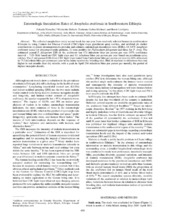Entomologic Inoculation Rates of Anopheles arabiensis in Southwestern Ethiopia
Peer reviewed, Journal article
Published version

Åpne
Permanent lenke
https://hdl.handle.net/1956/15637Utgivelsesdato
2013Metadata
Vis full innførselSamlinger
Originalversjon
https://doi.org/10.4269/ajtmh.12-0745Sammendrag
We collected anophelines every second week for one year from randomly selected houses in southwestern Ethiopia by using Centers for Disease Control (CDC) light traps, pyrethrum spray catches, and artificial pit shelter constructions to detect circumsporozoite proteins and estimate entomologic inoculation rates (EIRs). Of 3,678 Anopheles arabiensis tested for circumsporozoite proteins, 11 were positive for Plasmodium falciparum and three for P. vivax. The estimated annual P. falciparum EIR of An. arabiensis was 17.1 infectious bites per person per year (95% confidence interval = 7.03–34.6) based on CDC light traps and 0.1 infectious bites per person per year based on pyrethrum spray catches. The P. falciparum EIRs from CDC light traps varied from 0 infectious bites per person per year (in 60% of houses) to 73.2 infectious bites per person per year in the house nearest the breeding sites. Risk of exposure to infectious bites was higher in wet months than dry months, with a peak in April (9.6 infectious bites per person per month), the period of highest mosquito density.